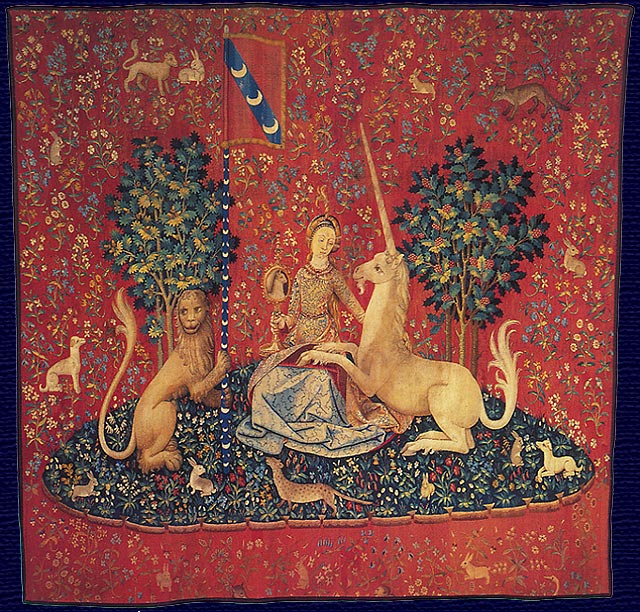
I often feel like an exhibit.
That is because of the rarity of my red hair and the shape of my naked body.
On a recent trip to Europe with my husband, I learned a tremendous amount about my marriage, my sexuality, my body, and especially my capacity to sense myself. This personal set of revelations started while at the Cluny Museum in Paris, a museum dedicated to medieval art.
I was in the gallery for The Lady and the Unicorn, which is a series of six tapestries woven in Flanders from wool and silk dated from the year 1500. Five of the six tapestries are said to represent the five traditionally recognized senses—with a radical twist.
The sixth tapestry is often interpreted as representing love. I sat before it, planning to meditate on the concept of “love as a sixth sense.”
In fairness, others interpret the sixth tapestry as representations of understanding or virginity, but love struck me in the moment—and that’s the interpretation that resonated most with me.
Previously, I thought of love as an igniter of the five traditionally recognized senses, and not a sense itself. The tapestry suggests that the idea of “love as a sixth sense” is at least 517 years old, but it’s certainly new to me.
At this time, instead of using the concept of love to manifest positive feelings toward myself, I perceived myself through love—using love as a conduit to embrace radical self-acceptance.
As I started to cry, lifted from the fog of abuse, I surrendered to the acknowledgement that—like so many of us—I was mortified by my naked body.
Giving myself permission to be freed from the prison of shame, I sensed love for my entire self for the first time. Previously, I only felt this way about parts of myself.
“There’s nothing shameful about experiencing our nakedness. People have perverted our natural beauty, our nakedness,” our tour guide said earlier in the day—and that statement came to mind while I was admiring the tapestry, even though there wasn’t nudity in it.
I’ll never forget these words, for this simple sentence—born out of an assessment of art history in the basement of a museum—was the liberation I’d been yearning for, for nearly a decade.
I’ve come to learn that I had internalized an accumulation of multi-generational and multi-cultural shame for nakedness, which manifested in my inability to perceive my body fully through love—the root of my maladaptive coping.
While sitting in front of one of the greatest works of art from the Middle Ages—on my birthday, no less—I finally understood love, and love of self, as a sixth sense.
Love, as a sixth sense, is the mechanism through which we physiologically and intrinsically feel self-worth, acceptance, affection, and regard for our own well-being and happiness.
I finally realized that our barest and most vulnerable selves is to be perceived without shame by all the senses, including the sense of love.
Inspired to continue sensing love, no differently than I sense other stimuli, I thought it might be interesting to fuse loving-kindness meditation with a basic sensory meditation.
I experimented and engaged with a self-guided meditation of the five traditionally recognized senses, but concluded with exploring love as a sense, instead of as an object or emotion.
I created a guided meditation that I call “Returning Home,” and I’ve used it daily now.
With increased wakefulness and friendliness in a comfortable and dignified seated position, I start with breath awareness to settle into the moment for about two minutes.
I then gently guide my attention, in the present moment, to the sounds, aromas, tastes, light patterns and images (either with my eyes open with a soft gaze or closed), and touch of either the naked or clothed physical body, always spending a few seconds feeling my heartbeat.
Then, after guiding my attention to the sense of my heart beating, I invite myself to send love to myself, those I love, those I feel neutral about, and to all beings by reciting: “Just as I wish too, may you be safe, may you be healthy, may you live with ease, peace, and joy.”
Lastly, I focus my attention not on the act of receiving and sending love, but on the sensations I have—knowing that I am and feel loved by many in diverse ways, and that I too send love well.
I gently refocus my attention on my breath awareness, until I feel ready to open my eyes.
Without grasping, resisting, or developing storylines to explain why I sense as I do, I notice, acknowledge, and try to let go, if needed.
Derek Walcott writes, in his poem, “Love After Love:”
“The time will come when, with elation, you will greet yourself arriving at your own door…You will love again the stranger who was yourself.”
And this is why I meditate—to return home to the stranger who was myself and to sense love for the very human, beautiful, imperfect woman that I am.
I encourage us all to try to tap into the sense of love, while extending it to everyone. Cultivating love and perceiving through love have become key ways for me to adapt to today’s chaotic and concerning world and to navigate a personal journey of health and healing.
Meditating on the sixth sense of love anchors us in our breath and in ourselves—in our home.
~
Author: Genevieve Gellert-Ilg
Image: Unsplash; Wikimedia Commons
Editor: Leah Sugerman
Copy Editor: Callie Rushton
Social Editor: Yoli Ramazzina






Read 0 comments and reply